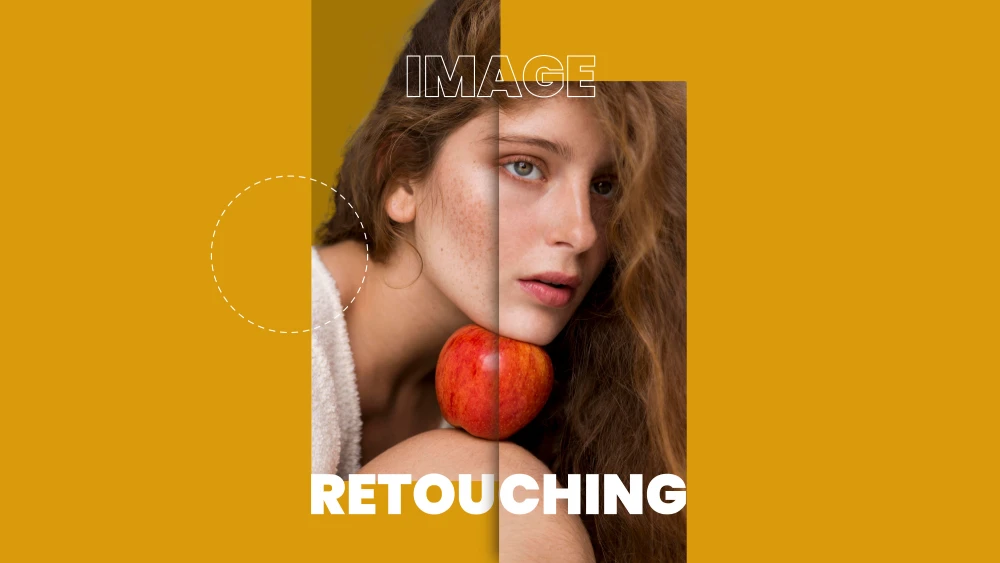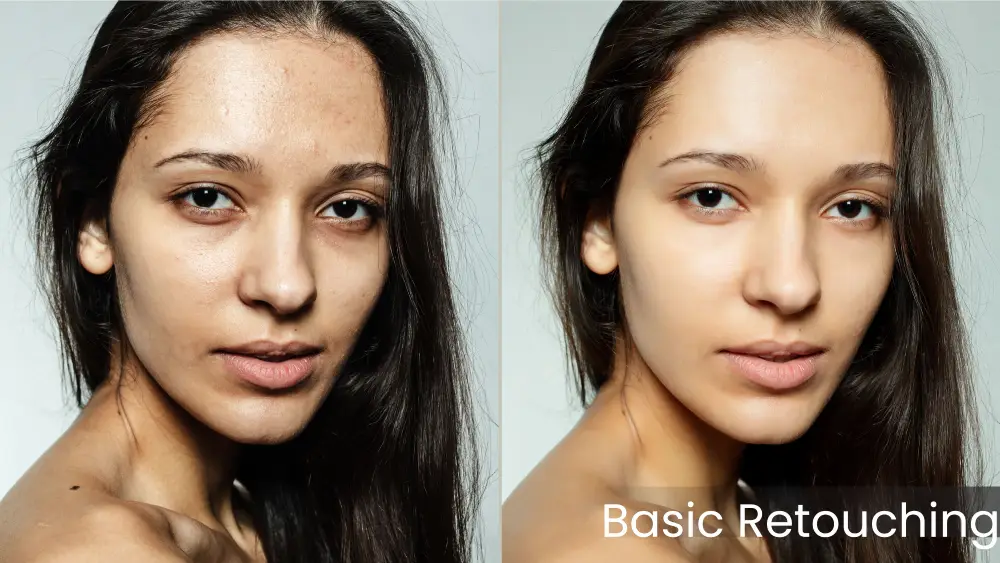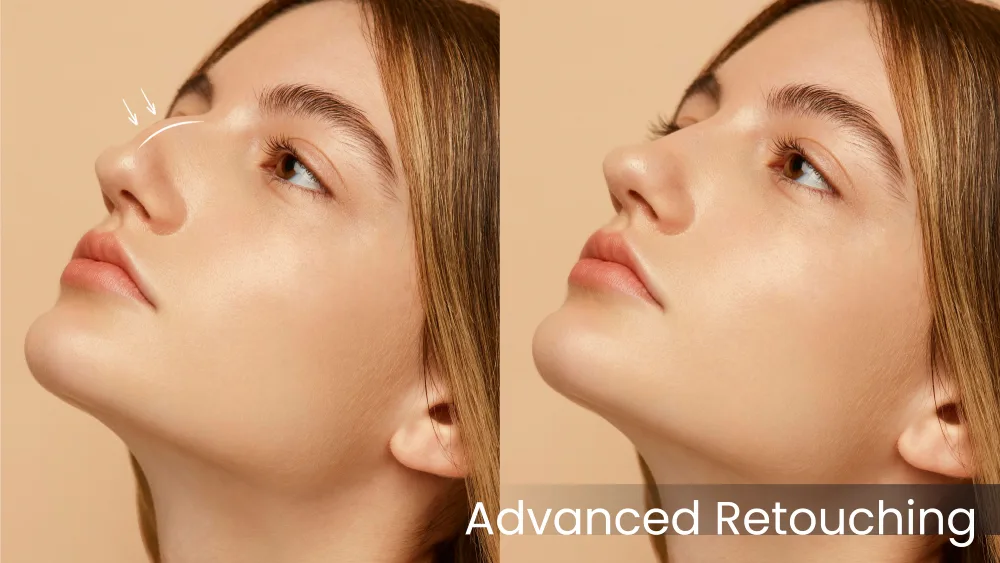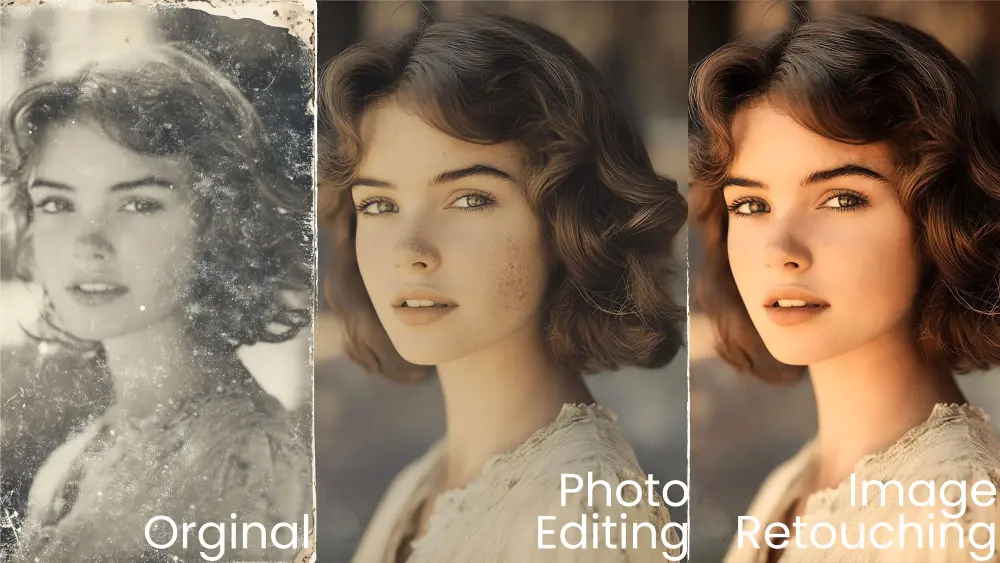In today’s image-driven digital world, visuals often create the first impression. No matter what sort of photography you do, be it wedding photography, photography for digital marketing, eCommerce brand, or as a social media manager, how your audience sees who directly gets impacted by the images' quality. This, in turn, means image retouching is crucial no matter what. It’s not about making people or products look unreal; it’s about enhancing photos to ensure they tell your story in the best possible light.
To make professional quality edits quickly and easily accessible, powerful tools like Retouched.ai, Photoshop, and Luminar Neo are using Ai. In this article, you will get to know more about image retouching, its importance across industries, and how you can leverage the latest tools for flawless visual content.
What Is Image Retouching?
Image retouching, also known as photo retouching, refers to the process of enhancing an image by removing imperfections, adjusting elements such as lighting or color, and improving overall visual quality. It’s essentially digital polishing, whether you're smoothing skin in a portrait or cleaning up a background in a product photo.

Retouching is more than just simple editing like cropping or adjusting exposure. Achieving that artful blend of natural yet striking final results requires an eye for detail. It might include:
- Removing blemishes or wrinkles
- Smoothing skin tones
- Brightening eyes or teeth
- Adjusting color balance or shadows
- Cleaning up backgrounds
The goal is to keep things realistic while showing the subject in the most accurate and engaging way possible.
What Are the Different Types of Photo Retouching?
Photo retouching can be categorized into several types, depending on the purpose and level of enhancement required. Here are some common types:
Basic Retouching

Basic retouching is the process of making simple yet effective enhancements to an image to improve its overall quality. Here, adjusting brightness, contrast, and color balance to achieve a more visually appealing appearance. Other standard methods include removing minor blemishes, whitening teeth, improving eyes, and shining skin for a polished appearance.
This type of retouching is widely used in portrait photography, product images, and social media content to refine photos without changing their natural appearance.
High-End Photo Retouching
High-end retouching produces flawless, magazine-quality images through the application of refined methods. It employs detailed skin smoothing with frequency separation to preserve natural texture, refined texturing for clothing and environments, dodge and burn methods for added dimension, and professional color grading to establish specific moods.
This approach is common in fashion editorials, luxury advertising, and high-profile commercial campaigns where visual perfection is expected.
Portrait Retouching
Portrait retouching improves human subjects while maintaining their authentic visual appearance. It includes skin softening that keeps essential texture elements, hair correction for flyaway and volume, eye and teeth enhancement for brighter focal features, and background adjustments to draw attention to the subject.
This specialized approach strikes a balance between enhancing and maintaining identity, making it ideal for professional headshots, family portraits, and personal branding imagery.
Product Photo Retouching
Product retouching presents merchandise with perfect clarity and appeal. It involves background cleanup or removal for distraction-free presentation, precise color correction to match real-life looks, and detail enhancement to highlight textures and features.
This technical discipline requires an understanding of materials and consumer psychology to effectively showcase products for e-commerce, catalogs, and advertising materials.
Jewelry Photo Retouching
Jewelry photo retouching is the process of enhancing and refining images of jewelry to make them look more polished, professional, and visually appealing.
This is especially important for e-commerce, advertising, and luxury branding, where high-quality images can significantly impact sales.
Real Estate Photo Retouching
Real estate photo retouching enhances property images to improve their appeal and marketability. It improves lighting, replaces dull skies, corrects lens distortion, adjusts colors, removes distractions, and adds virtual staging. These refinements create polished, professional photos that attract buyers and boost sales.
eCommerce Photo Retouching
eCommerce retouching creates consistent, high-converting product images for online marketplaces. It highlights the use of a white background to meet platform requirements, proper image sizing for various display environments, and details that underline key selling features.
This approach ensures cohesive brand presentation while maintaining accuracy directly correlating with higher conversion rates and reduced returns due to satisfied customer expectations.

The Importance of Image Retouching in Modern Photography
Builds Brand Credibility and Trust
Professional images boost the credibility of a brand. Consistency in the look of product images, social media posts, and ads sends the message of reliability. When customers view lovely images, they automatically relate them to a nice brand. It can work wonders in changing their shopping habits.
For example, in online stores, product images are often the customer's initial experience of a brand. If the images are professionally retouched, they can make a fantastic first impression, and the brand is sensed as more professional and trustworthy.
Drives Higher Engagement
Vibrant, well-lit, and distraction-free photos capture attention and inspire likes, shares, and buys. In today's social media era, pictures are the rules. Social networking websites such as Instagram, Pinterest, and Facebook thrive on good-looking content.
Photoshopped images are the center of attention in congested feeds, capturing the viewer's eye and prompting them to engage with the content. Interaction can lead to increased website traffic, higher sales, and enhanced overall brand exposure.
Reduces Costly Reshoots
Slow retouching can rescue photos that would otherwise be destined for the garbage can, saving time and money. Occasionally, despite the most careful planning on location, elements within a photo will refuse to cooperate.
The retouching will address these issues, such as lighting, unwanted shadows, or minor blemishes, thereby eliminating the need for expensive reshoots. Such efficiency is crucial in commercial photography, where time and money are often valuable assets.
Enhances Visual Storytelling
A well-retouched photo leads the viewer's eyes toward the subject and creates a tone or mood that is consistent with your message. Photography is a powerful tool for effective communication. By using careful retouching, photographers can effectively highlight specific aspects of an image, guide the viewer's eye, and produce an emotional response.
Whether it's a dynamic portrait, a peaceful landscape, or a colorful product photo, retouching is used to convey the desired narrative and connect with viewers on an emotional level.
Improves Conversion Rates
High-quality, retouched product images have a directly impact on sales performance. Market analysis reports say that customers are more likely to purchase products featuring clear and attractive photos. Professional retouching removes barriers to purchase by presenting products in their best light, reducing customer uncertainty and boosting conversion rates.
Mastering Techniques Applied in Image Retouching
Image retouching techniques can be categorized into three skill levels, each building upon the previous one to create professional-quality results.
Basic Level Photo Retouching Techniques
- Exposure and Brightness Correction - Basic adjustments for proper lighting balance.
- Crop and Straighten - Improving formatting and correcting tilted horizons.
- Basic Spot Removal - Simple healing tools for blemishes and dust spots.
- Auto Color and Contrast - Quick automated improvements for basic issues.
- Basic Saturation Adjustments - Simple vibrance controls for more appealing colors.

Advanced Photo Retouching Techniques
- Frequency Separation - Splits texture from color on portraits for smooth skin while keeping natural texture.
- Dodge & Burn - Strategic highlighting and shading to add depth and define features.
- Color Correction - Precise color balance adjustments for accurate representation.
- Clone Stamp & Healing Brush - Advanced tools for removing distractions and flaws.
- Layer Masking - Precise control over which areas receive specific adjustments.
- Adjustment Layers - Non-destructive editing for brightness, contrast, and color modifications.
High-End Photo Retouching Techniques
- Advanced Compositing - Combining multiple images seamlessly with matched lighting.
- Hair Retouching - Individual strand work for natural-looking hair enhancement.
- Skin Retouching - Professional-level skin smoothing beyond basic frequency separation.
- Color Grading - Artistic color manipulation for mood and atmosphere creation.
- Background Replacement - Complex subject extraction and new background integration.
- Product Retouching - Specialized techniques for commercial product photography.
Those techniques are used to create professional retouching image workflows that produce flawlessly retouched images.
The Use of AI in Image Retouching
AI is revolutionizing professional image retouching. Software such as Retouched.ai, Adobe Photoshop Neural Filters, Luminar Neo, and Skylum AirMagic now complete complex tasks at breakneck speed and precision. Here's why they're revolutionary:
Speed and Efficiency
AI can do batch work and repetitive tasks within seconds. This feature is beneficial to photographers and companies that need to process large quantities of images within tight time frames. AI can automate background removal, color grading, and smoothing out faces, saving a considerable amount of time from manual editing.
User-Friendly Interfaces
Tools like Retouched.ai are designed for professional-level retouching by non-designers. These are incredibly easy-to-use and clear interfaces, allowing users to achieve professional-level outcomes without receiving special training or years of practice. As a result of this democratization of retouching software, more people can produce high-quality images regardless of their level of skill.
Consistent Results
Most suitable for companies that require consistency across multiple image groups. Consistency is what branding is all about, and AI tools are most adept at it for multiple images. From the very fact that all the product images must have the same color tone to images requiring the same skin tones, AI can provide consistent and replicable results.
Smart Automation
AI software can now recognize faces, textures, and lighting patterns to touch up images sensitively. Advanced algorithms can not just read the content of a photograph but also provide corollary edits depending on context. For instance, AI can recognize facial features and selectively enhance them or recognize multiple textures and proportionally adjust them accordingly.
Why Image Retouching Is Essential to Many Industries
Now, image retouching is important for every industry to achieve more value and ROI. Here are some selective industries we have mentioned:
eCommerce
Retouching helps high-converting product pages with clear, detailed, and consistent images. In the highly competitive online shopping environment, product images are crucial for attracting and having customers. Retouched images can effectively highlight product benefits, place key items, and create a desirable visual shopping experience.
Fashion
Luxury retouching brings catwalk and editorial photo shoots to perfection. Fashion photography requires precision and artistry to the highest standards. Retouching can enhance the visual effect of fashion photographs, ranging from smoothing skin and adjusting light and dark tones to idealizing the texture and color of clothing.
Real Estate
Improves the listings more attractive through improved perspective and lighting. Real estate photography is significantly enhanced by retouching, as it can make properties appear more gorgeous and larger in scale. Using HDR blending, perspective correction, and color enhancement can turn ordinary photos into stunning images.
Jewelry & Luxury Goods
Spotlights fine details and textures for visual appeal. Detail work is necessary for jewelry and high-end products to accentuate their beauty and craftsmanship. Retouchers can enhance lustrous, smooth metal textures and ensure that all details are accurately photographed.
Weddings
Subtle retouching enhances each photograph's appearance without appearing unnatural. Wedding photography is all about capturing personal moments. Retouching would enhance the natural look of the photographs and preserve the distinctness of the moments. Smoothing out the skin, correcting colors, and eliminating background noise are some of the standard steps that render wedding photographs impeccable.
How to Select the Best Image Retouching Services?
The proper selection of image retouching service guarantees that your photos are of the highest quality and professionalism. Below are some key points that will help you in making the right decision:
- Check Portfolios: Scroll through before-and-after examples. A portfolio is a reflection of an artist's creativity and artistry as a retoucher. Scrolling through their past work, you can assess how well they can work with various types of images and retouching types. Observe their quality and texture in editing. Are the photos retouched but not over-touched? Do they look natural in erasing imperfections? These are giveaway signs of a master retoucher.
- Assess Turnaround Time: Deadlines matter, especially for campaigns. Having the ability to deliver high-quality retouched photographs within a mutually agreed period is critical, especially for businesses that require timely visuals for marketing and promotional campaigns. When requesting a retouching service, ask about their turnaround times and determine if they can meet yours without compromising quality.
- Read Reviews: Client reviews can help explain the quality and reliability of a service. Client feedback and reviews are good indicators of the retoucher's professionalism, communication skills, and overall service quality. Pay attention to reviews that mention the retoucher's deadline satisfaction, their reaction to critiques, and whether the client is satisfied with the end product. You can check those reviews from Google Maps, Trustpilot, GoodFirms, or social media.
- Choose an Expert: Select a team that is experienced in your field (e.g., fashion, products, or real estate). Each industry has specific needs for image retouching. Fashion photography often involves heavy skin smoothing and color correction, whereas real estate photography may require only improved lighting and perspective. Selecting a retoucher who knows your exact field ensures they understand the subtleties and can provide images in line with industry expectations.
At The KOW Company, we cover all those topics. If you want to try our services, you can send us test works for free. After that, when you receive the results, and if you think we can proceed with your project, then we can move forward.

Image Retouching vs. Photo Editing: What's the Difference?
The difference between image retouching and photo editing is a key consideration for achieving the desired result in your photos.
- Photo Editing: Photo editing is preparatory work, including cropping, adjusting exposure, and overall fine-tuning. It is the overall adjustment of a photo to ensure it is generally improved. It can be cropped for purposes of compositional enhancement, exposure for proper lighting, and overall color balance. It is where image improvement typically begins and prepares the scene for more advanced retouching.
- Image Retouching: Retouching is refining the art of singing a picture. Retouching a picture is more advanced than simple editing to make a specific area of a picture better. Operations involved include skin smoothing, blemish removal, color correction, and object removal or addition. There is more skill and detail required in retouching because slight movements are made to make the picture look slick and professional.
Both photo retouching and photo editing are necessary, but they serve different roles in improving the image. Photo editing prepares the image for retouching, and retouching adds the final touches that enhance the image.
Common Tools and Software for Image Retouching
There are many tools and software used in the image retouching process. Each has unique features and functions for different retouching tasks.
Retouched.ai
It is specifically designed for fast and high-quality retouching using artificial intelligence. Retouched.ai is perfect for anyone who looking for consistent, studio-quality results at low cost. Suitable for use in eCommerce, portraits, and social media photos. It uses advanced algorithms to perform complex retouching processes automatically, saving time and effort.
Adobe Photoshop
The professional standard for retouching. Photoshop provides slight control using tools such as the Healing Brush, Clone Stamp, Layers, and Adjustment Masks. Particularly suited to advanced edits and professional-standard results. Photoshop is popular among retouchers due to its flexibility and powerful features. It provides delicate and elegant retouching, making it particularly suited to high-end fashion, product, and portrait photography.
Lightroom
Best suited for batch processing and global edits. Lightroom excels at exposure correction, color grading, and catalog organization, making it the photographer's preference when handling large numbers. Its non-destructive editing feature and friendly interface make it perfect for rapid and effective photo processing.
Luminar Neo
It combines AI enhancements with creative filters. Luminar Neo is renowned for its easy interface and advanced features, including AI Sky Replacement and Skin Enhancer. It is excellent for both photographers and content creators. It offers a range of AI-driven tools that simplify the retouching process to get unique results.
GIMP
A free, open-source alternative to Photoshop. GIMP offers many advanced retouching features, though with a steeper learning curve and fewer automation options than its paid partners. It is a powerful tool for those who require professional-grade retouching capabilities without the expense of commercial software.
Capture One
Professional photographers prefer it for its superior color grading and tethered shooting features. It also offers detailed retouching tools and high performance with RAW files. Capture One is known for its exceptional image quality and precise control over color and tone adjustments.
Fotor
It's a user-friendly app for quick edits. Fotor is ideal for social media visuals, with built-in filters and basic AI-powered enhancements. It is perfect for users who need to create visually appealing content quickly and easily.
Frequently Asked Questions
What is image retouching or photo retouching?
It’s the process of enhancing a photo by correcting flaws and improving its visual quality. Retouching involves making detailed adjustments to an image to enhance its overall quality and visual impact.
What does a retouched image mean?
A retouched image means a photo that’s been enhanced to look more polished and visually amazing. Here, images are purified to remove imperfections and highlight the best features of the subject.
How to retouch an image in Photoshop?
To retouch an image, you need to use tools like the Healing Brush, Clone Stamp, Dodge & Burn, and Adjustment Layers. These tools are used for clear and detailed retouching, enabling you to correct flaws and enhance the image.
Why is image retouching important for businesses?
It helps present a polished, professional, and trustworthy brand image. High-quality visuals are essential for building credibility and attracting customers.
Do wedding photographers retouch photos?
Yes, usually, light enhancements keep the natural, emotional tone of the event. Often, they retouch images to enhance their beauty while keeping authenticity.
How long does it take to retouch a photo?
The time required to retouch a photo depends on its complexity; basic edits typically take around 5-15 minutes, while advanced or high-end retouching can take 30 minutes to a couple of hours or more per image.
How much does photo retouching cost?
Basic edits start around $0.5–$10 per image; high-end services cost more. The cost of retouching depends on the complexity and quality of the edits required.
Is AI photo retouching reliable?
Yes, but complex creative edits may still need a human touch. AI tools are effective for automating repetitive tasks and achieving consistent results.
Conclusion
Image retouching isn’t about creating something fake, it’s about helping your photos represent the best version of reality. Whether you’re refining a portrait, selling a product, or showcasing a space, polished visuals make a powerful difference. High-quality retouching enhances the appeal of your images, builds trust with your audience, and elevates your brand's credibility. By choosing the right tools and services, you can ensure your photos always look their best and effectively communicate your message.
With the right tools and services, especially AI-powered platforms like Retouched.ai, you can streamline your workflow, stay on trend, and consistently produce images that wow. In the visual-first world, retouching isn’t optional. It’s essential.
